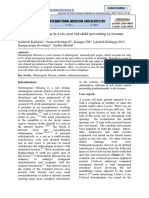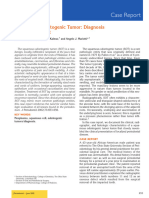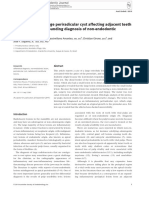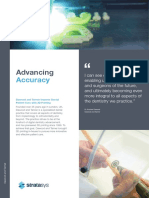Scleroderma PDF
Scleroderma PDF
Uploaded by
lupusebastianCopyright:
Available Formats
Scleroderma PDF
Scleroderma PDF
Uploaded by
lupusebastianOriginal Title
Copyright
Available Formats
Share this document
Did you find this document useful?
Is this content inappropriate?
Copyright:
Available Formats
Scleroderma PDF
Scleroderma PDF
Uploaded by
lupusebastianCopyright:
Available Formats
Case Report/Clinical Techniques
Root Resorption Associated with Mandibular Bone
Erosion in a Patient with Scleroderma
Maria Antonia Zancanaro de Figueiredo, BDS, PhD*
Jose Antonio Poli de Figueiredo, BDS, MSc, PhD and
Stephen Porter, MD, PhD, FDS RCS, FDS RCSE*
Abstract
A rare feature of mandibular bone erosion and external
apical resorption of a mandibular left third molar (tooth
#17) in a patient with scleroderma is described. Scleroderma is characterized by vascular and fibrous changes
of the mucocutaneous surfaces and viscera caused by
immunologically mediated connective tissue disorders.
A dental panoramic tomogram of the patient revealed
notable erosion of the left ramus, the inferior border of
the mandible, and the left coronoid process. Resorption
of the distal root of the tooth #17 was notable, coincident with the mandibular erosive process, and such
association has not yet been reported. The report details the possible cause of this unusual presentation of
tooth root resorption. The increased physical pressure
of the tight facial mucocutaneous tissues from the
scleroderma is likely to have participated in the resorptive process. (J Endod 2008;34:102103)
Key Words
Mandibular erosion, resorption, root, scleroderma
cleroderma is a group of immunologically mediated connective tissue disorders,
characterized by vascular and fibrous changes of the mucocutaneous surfaces and
viscera. It can give rise to a wide range of clinical features but in general can be classified
as localized or systemic (1, 2). Although rare, scleroderma has a worldwide distribution, usually manifesting clinically in early middle life, and it is 3 to 4 times more
common in women than men (1). The prevalence of scleroderma may be increasing as
a consequence of improved diagnostic methods and/or improvements in management
and, hence, patient survival (3). A wide pattern of abnormalities of soft and hard tissues
of the face and mouth can arise. Typical features include orofacial telangiectasia, tightening of the skin of the face gives rise to a loss of wrinkling, nasal beaking, and
microstomia. Salivary gland dysfunction manifesting as secondary Sjgrens syndrome
is common, and together with difficulties in maintaining good oral hygiene (as a consequence of microstomia and reduced manual dexterity), there may be an increased
risk of caries (4, 5).
Loss of facial hard tissue, presumably because of pressure atrophy, is a rare
feature. There is only one report of root resorption associated with scleroderma (6),
but to date there have been no reported instances of root resorption associated with
mandibular bone erosion in patients with scleroderma. The present report details the
features of a patient with resorption of the mandibular ramus and angle and external
resorption of the distal root of an adjacent permanent molar.
Case Report
From the *Oral Medicine Unit and Endodontology Unit,
UCL Eastman Dental Institute, London, United Kingdom; and
Oral Medicine Unit, Pontifical Catholic University of Rio
Grande do Sul, Sao Lucas Hospital, Porto Alegre, Rio Grande
do Sul, Brazil.
Address requests for reprints to Dr Jose Antonio Poli de
Figueiredo, Unit of Endodontology, UCL Eastman Dental Institute, 256 Grays Inn Road, London, UK WC1X 8LD. E-mail
address: j.figueiredo@eastman.ucl.ac.uk.
0099-2399/$0 - see front matter
Copyright 2008 by the American Association of
Endodontists.
doi:10.1016/j.joen.2007.10.021
A 43-year-old female patient was referred to the Oral Medicine unit of UCL Eastman
Dental Institute. Her principal complaint was difficulty eating as a consequence of loss
of some of her lower teeth. Clinical examination revealed facial telangiectasia and
microstomia, with an interincisal opening of approximately 2 cm. Intraorally, there was
no xerostomia, but there were a number of telangiectasia present on the hard palate and
the left and right anterior lateral borders of the tongue. There was no obvious sign of
active caries. Although there was generalized chronic marginal periodontitis, there was
no mobility of the present teeth.
A dental panoramic tomogram (Fig. 1) revealed notable erosion of the left ramus,
the inferior border of the mandible, and the left coronoid process. The roots of tooth
#30 were still in situ, and there was radiologic evidence of caries at the crown of tooth
#31. There was radiologic evidence of generalized chronic periodontitis. Of note, there
was mild apical resorption of the distal root of tooth #17 (Fig. 2). This resorption was
coincident with the mandibular erosive process. The distal root seemed blunted, and
the periodontal ligament displayed normal radiographic features. The tooth #17 responded positively to a sensitivity test with tetrafluorethane (Endo Ice, Whaledent,
Mahwah, NJ), which was similar to the other teeth present in the left quadrant. The tooth
root resorption was a radiographic finding. No specific treatment was suggested other
than follow-up radiographic assessment in 2 years.
Discussion
Bony resorption is an uncommon but recognized complication of longstanding
scleroderma. This resorption, presumably caused by pressure atrophy by the tight
mucocutaneous tissues, affects the inferior body of the mandible (giving rise to a
pregonial notch), angle, coronoid process of the mandible condylar process, and
102
de Figueiredo et al.
JOE Volume 34, Number 1, January 2008
Case Report/Clinical Techniques
occasionally the zygoma (2). Widening of the radiographic image of the
periodontal ligament may also arise. The only recorded finding of root
resorption tries to explain the process as a consequence of regressive
changes of pulpal tissue within root canals secondary to the systemic
sclerosis (6). However, in the present case, tooth sensitivity test was
performed, and the pulp reaction to the cold test was similar to the
unaffected teeth.
The present patient had root resorption of the apical third of the
distal root of a mandibular third molar adjacent to a site of gross
external bony resorption. The presence of the mandibular right
third molar enabled the comparison with an unaffected distal root.
It is likely that the affected root had greater resorption than that
detected radiologically (7).
The hard tissues (dentine, cementum, and enamel) of permanent
teeth do not normally undergo resorption (8), probably because of the
anti-invasion factor, a potent collagenase inhibitor present in cartilage,
blood vessel walls, and teeth (9). Resorption of permanent teeth is
usually the result of trauma or chronic inflammation of the pulp and/or
periodontal tissues. External resorption can also be induced by increased physical pressure in the periodontal ligament associated with
orthodontic tooth movement, tumors, or tooth eruption (10, 11). Resorption on the external root surface usually accompanies simultaneous
reactions within the alveolar bone; indeed, the process of tooth resorption is considered to be similar to that of bone resorption (9).
The etiology of different types of root resorption requires 2 phases:
injury to the protective tissues (mechanical or chemical) and stimulation by infection or pressure (11). Teeth with apical periodontitis are
likely to undergo inflammatory root resorption. It has been hypothesized that the oncotic pressure in periapical lesions caused by the presence of large protein molecules provides a common pressure pathway
for the different types of root resorption (12). However, the treatment is
related to the stimulating factors (13, 14).
The resorption of the present patient is unlikely to have been the
consequence of local occlusal forces. The present external resorption
would potentially be the consequence of the erosive process affecting
the adjacent mandible. This may have occurred as a result of the tight
facial mucocutaneous tissues from the scleroderma, initiating cell signaling to inhibit the anti-invasion factor in the cementum or periodontal
membrane cells (9) surrounding the periapex of this distal root. Additionally, there is deviation in the calcium and phosphorus contents and
Figure 1. A dental panoramic tomogram showing the affected left mandible with
erosion and resorption of the distal root of lower left third molar.
JOE Volume 34, Number 1, January 2008
Figure 2. A closer radiographic view of the area comprising the lower left third
molar and the eroded mandible.
an absence of magnesium in the dentine and decrease in the calciumphosphorus ratio in patients with scleroderma (15). This would allow
the root resorption to occur together with the bone resorptive process,
thus maintaining a minimal amount of trabecular and compact bone in
the area surrounding the distal root of the lower third molar. If the root
were maintained at its normal size and mandibular erosion continued,
the root apex would have become exposed, weakening the mandible.
The root resorption could be perceived to be a useful defense mechanism to maintain same normal bone structure and, thus, lessen the risk
of pathological fracture.
References
1. Ferri C, Valentini G, Cozzi F, et al. Systemic sclerosis: demographic, clinical and
serological features and survival in 1012 Italian patients. Medicine 2002;81:139 53.
2. Chaffee NR. CREST syndrome: clinical manifestations and dental management. J
Prosthodont 1998;7:155 60.
3. Mayes MD. Scleroderma epidemiology. Rheum Dis Clin North Am 2003;29:239 54.
4. Porter SR, Scully C. Oral manifestations of connective tissue diseases. Dent Update
2007 (in press).
5. Poole JL, Brewer C, Rossie K, Good CC, Conte C, Steen V. Factors related to oral
hygiene in persons with scleroderma. Int J Dent Hyg 2005;3:137.
6. Rout PG, Hamburger J, Potts AJC. Orofacial radiographic manifestations of systemic
sclerosis. Dentomaxillofac Radiol 1996;25:193 6.
7. Laux M, Abbott PV, Pajarola G, Nair PNR. Apical inflammatory root resorption: a
correlative radiographic and histological assessment. Int Endod J 2000;33:48393.
8. Pindborg JJ. Pathology of the dental hard tissues, 1st ed. Copenhagen: Munksgaard;
1970.
9. Lindskog S, Hammarstrm L. Evidence in favor of anti-invasion factor in cementum
or periodontal membrane of human teeth. Scand J Dent Res 1980;88:1613.
10. Gunraj MN. Dental root resorption. Oral Surg Oral Med Oral Pathol Oral Radiol
Endod 1999;88:64753.
11. Fuss Z, Tsesis I, Lin S. Root resorption: diagnosis, classification and treatment
choices based on stimulation factors. Dent Traumatol 2003;19:175 82.
12. Vier FV, Figueiredo JAP. Prevalence of different periapical lesions associated with
human teeth and their correlation with the presence and extension of apical external
root resorption. Int Endod J 2002;35:710 9.
13. Wood P, Rees JS. An unusual case of furcation external resorption. Int Endod J
2000;33:530 3.
14. Fayad S, Steffensen B. Root resorptions in a patient with hemifacial atrophy. J Endod
1994;20:299 303.
15. Knychalska-Karwan Z, Pawlicki R, Karwan T. Morphology and microanalysis of teeth
in scleroderma. Folia Histochem Cytobiol 1986;24:257 62.
Root Resorption and Mandibular Bone Erosion with Scleroderma
103
You might also like
- First Order Second OrderDocument12 pagesFirst Order Second OrderSrishti Syal67% (3)
- Tweed - The Frankfort-Mandibular Plane Angle in Orthodontic Diagnosis, Classification, Treatment Planning, and Prognosis PDFDocument56 pagesTweed - The Frankfort-Mandibular Plane Angle in Orthodontic Diagnosis, Classification, Treatment Planning, and Prognosis PDFWendanNo ratings yet
- The Vertical Dimension in Prosthesis and Orthognathodontics PDFDocument380 pagesThe Vertical Dimension in Prosthesis and Orthognathodontics PDFPatri Meisaros100% (2)
- Preventive Orthodontics Grand FInaleLDocument90 pagesPreventive Orthodontics Grand FInaleLMano ManiNo ratings yet
- Impaction SDocument127 pagesImpaction SVaibhav Nagaraj75% (4)
- Internal ResorptionDocument4 pagesInternal ResorptionmaharaniNo ratings yet
- Cs LobodontiaDocument3 pagesCs LobodontiaInas ManurungNo ratings yet
- Odontogenic FibromaDocument5 pagesOdontogenic FibromaGowthamChandraSrungavarapuNo ratings yet
- Cracked Tooth 4Document4 pagesCracked Tooth 4srinivasanNo ratings yet
- Refiana Novia - J530235015 - Idiopathic OsteosclerosisDocument4 pagesRefiana Novia - J530235015 - Idiopathic OsteosclerosisHanifNo ratings yet
- Fibrous Dysplasia of The Jaw Bones: Clinical, Radiographical and Histopathological Features. Report of Two CasesDocument8 pagesFibrous Dysplasia of The Jaw Bones: Clinical, Radiographical and Histopathological Features. Report of Two CasesChristopher CraigNo ratings yet
- Traumatic Bone Cyst of Idiopathic Origin? A Report of Two CasesDocument5 pagesTraumatic Bone Cyst of Idiopathic Origin? A Report of Two CasesjulietNo ratings yet
- How Can We Diagnose and Treat Osteomyelitis of The Jaws As Early As PossibleDocument11 pagesHow Can We Diagnose and Treat Osteomyelitis of The Jaws As Early As Possiblebucomaxilofacial.hfiNo ratings yet
- Case Report Ameloblastic Fibroma: Report of 3 Cases and Literature ReviewDocument5 pagesCase Report Ameloblastic Fibroma: Report of 3 Cases and Literature ReviewcareNo ratings yet
- Florid Cemento-Osseous Dysplasia Report of A Case Documented With ClinicalDocument4 pagesFlorid Cemento-Osseous Dysplasia Report of A Case Documented With ClinicalDwiNo ratings yet
- Periapical Cemento-Osseous Dysplasia Clinicopathological FeaturesDocument4 pagesPeriapical Cemento-Osseous Dysplasia Clinicopathological FeaturesCindyNo ratings yet
- Tumor Diagnosis ManagementDocument4 pagesTumor Diagnosis ManagementNajmaldeen AbdualhafeezNo ratings yet
- A Rare Case Report Along With Surgical Management of Bilateral Maxillary Buccal Exostosis in A Patient of Polydactyly and Distomol.Document3 pagesA Rare Case Report Along With Surgical Management of Bilateral Maxillary Buccal Exostosis in A Patient of Polydactyly and Distomol.Fransiski HoNo ratings yet
- Managing Oral Side Effects of Systemic Diseases: Prosthetic Rehabilitation With Amyloidosis of The TongueDocument17 pagesManaging Oral Side Effects of Systemic Diseases: Prosthetic Rehabilitation With Amyloidosis of The TongueRandy Ichsan AdlisNo ratings yet
- InterplayDocument9 pagesInterplayalbertoborfeNo ratings yet
- Esclerosis TuberosaDocument4 pagesEsclerosis TuberosaJesus NietoNo ratings yet
- Post Extraction Lingual Mucosal Ulceration With Bone NecrosisDocument11 pagesPost Extraction Lingual Mucosal Ulceration With Bone NecrosisKrisbudiSetyawanNo ratings yet
- Bilateral Fusion of Mandibular Second Molars With Supernumerary Teeth: Case ReportDocument5 pagesBilateral Fusion of Mandibular Second Molars With Supernumerary Teeth: Case ReportUcc Ang BangarenNo ratings yet
- 51 667 1 PBDocument2 pages51 667 1 PBMax FaxNo ratings yet
- 41 JOE Dentigerous Cyst 2007Document5 pages41 JOE Dentigerous Cyst 2007menascimeNo ratings yet
- External Root Resorption Associated With Impacted Third Molars: A CaseDocument6 pagesExternal Root Resorption Associated With Impacted Third Molars: A CaseMuskab JonasNo ratings yet
- Fibrous Dysplasia of The Anterior Mandible: A Rare Case: NtroductionDocument8 pagesFibrous Dysplasia of The Anterior Mandible: A Rare Case: NtroductionYudha Sandya PratamaNo ratings yet
- Dentomaxillofacial Radiology (2005) 34, 240-246 Q 2005 The British InstituteDocument7 pagesDentomaxillofacial Radiology (2005) 34, 240-246 Q 2005 The British Institutechonlada_laiedNo ratings yet
- Bilateral Maxillary Dentigerous Cysts - A Case ReportDocument3 pagesBilateral Maxillary Dentigerous Cysts - A Case ReportGregory NashNo ratings yet
- Atypically Grown Large Periradicular Cyst Affecting Adjacent Teeth and Leading To Confounding Diagnosis of Non-Endodontic PathologyDocument10 pagesAtypically Grown Large Periradicular Cyst Affecting Adjacent Teeth and Leading To Confounding Diagnosis of Non-Endodontic PathologyJorge OrbeNo ratings yet
- 4 ImpactionDocument188 pages4 ImpactionD YasIr MussaNo ratings yet
- Internal and External ResorptionDocument10 pagesInternal and External Resorptiongsshy.92No ratings yet
- Tissue Response To Dental CariesDocument24 pagesTissue Response To Dental CariesGabriel Miloiu100% (1)
- Osteosarcoma of Mandible: Abst TDocument3 pagesOsteosarcoma of Mandible: Abst TTriLightNo ratings yet
- Torus InglesDocument5 pagesTorus InglespaolaNo ratings yet
- Exostosis MandibularDocument6 pagesExostosis MandibularCOne Gomez LinarteNo ratings yet
- Odontogenic Keratocyst - A Deceptive EntityDocument4 pagesOdontogenic Keratocyst - A Deceptive EntityIJAR JOURNALNo ratings yet
- DT DEC 15 Germain FNLDocument10 pagesDT DEC 15 Germain FNLKranti PrajapatiNo ratings yet
- KJDMR 0502006Document6 pagesKJDMR 0502006reema hawasNo ratings yet
- Razan NewDocument8 pagesRazan NewRazan OthmanNo ratings yet
- Ameloblastic Fibroma: Report of A Case: Su-Gwan Kim, DDS, PHD, and Hyun-Seon Jang, DDS, PHDDocument3 pagesAmeloblastic Fibroma: Report of A Case: Su-Gwan Kim, DDS, PHD, and Hyun-Seon Jang, DDS, PHDdoktergigikoeNo ratings yet
- Intern Journal Reading-Paget's Disease-Root Resorption-Oral Surg-2008Document4 pagesIntern Journal Reading-Paget's Disease-Root Resorption-Oral Surg-2008Nurani AtikasariNo ratings yet
- Pratica 2Document5 pagesPratica 2Emiliano ArrietaNo ratings yet
- Emdogain 1Document6 pagesEmdogain 1Nicco MarantsonNo ratings yet
- Asds 08 1812Document4 pagesAsds 08 1812Gulhyder ZardariNo ratings yet
- ImpactionDocument11 pagesImpactionKhalid AgwaniNo ratings yet
- Etiology - Pulpal IrritantsDocument18 pagesEtiology - Pulpal IrritantsAnang AbdulfattahNo ratings yet
- Submerged Human Deciduous Molars and AnkylosisDocument4 pagesSubmerged Human Deciduous Molars and AnkylosisjesuNo ratings yet
- Endodontic Treatment of Dens InvaginatusDocument7 pagesEndodontic Treatment of Dens InvaginatusParidhi GargNo ratings yet
- Combined Orthodontic - .Vdphjohjwbm5Sfbunfoupgb Q 1ptupsuipepoujd (Johjwbm3FdfttjpoDocument16 pagesCombined Orthodontic - .Vdphjohjwbm5Sfbunfoupgb Q 1ptupsuipepoujd (Johjwbm3FdfttjpobetziiNo ratings yet
- New Approach in Extraction of Impacted Wisdom Teeth: Dr. Mike Y Y LeungDocument2 pagesNew Approach in Extraction of Impacted Wisdom Teeth: Dr. Mike Y Y Leungandrada67100% (1)
- Oral Patho Lec.5 Inflammatory Bone Diseases P.1.PDFDocument16 pagesOral Patho Lec.5 Inflammatory Bone Diseases P.1.PDFmar21d0011No ratings yet
- Internal Root Resorption Case SeriesDocument5 pagesInternal Root Resorption Case SeriesDana StanciuNo ratings yet
- JOralMaxillofacRadiol3270-5211945 142839Document6 pagesJOralMaxillofacRadiol3270-5211945 142839Ankit SahaNo ratings yet
- Osteoma 1Document3 pagesOsteoma 1Herpika DianaNo ratings yet
- Molar Impactions: Etiology, Implications and Treatment Modalities With Presentation of An Unusual CaseDocument3 pagesMolar Impactions: Etiology, Implications and Treatment Modalities With Presentation of An Unusual Casemagus davilaNo ratings yet
- Jurnal GicDocument6 pagesJurnal GicHusnul KhatimahNo ratings yet
- UntitledDocument6 pagesUntitledsanaNo ratings yet
- Joddd 5 102Document4 pagesJoddd 5 102Trần ThưNo ratings yet
- Copia de Tissue Response To Dental CariesDocument7 pagesCopia de Tissue Response To Dental Cariesjorefe12No ratings yet
- Hyaline ring granulomaDocument4 pagesHyaline ring granulomarachellamarckNo ratings yet
- Art 12Document4 pagesArt 12Adelina MijaicheNo ratings yet
- Obliterated Central Incizor - 2011Document21 pagesObliterated Central Incizor - 2011Slavica Gjurceska-GorjanskaNo ratings yet
- Rico Short CBCTDocument14 pagesRico Short CBCTlupusebastianNo ratings yet
- EBOOK Rotativ VS Reciproc PDFDocument10 pagesEBOOK Rotativ VS Reciproc PDFlupusebastianNo ratings yet
- Biomechanical Relationship 19831Document7 pagesBiomechanical Relationship 19831lupusebastianNo ratings yet
- IRIGANTI The Effects of Temperature On Sodium HypochloriteDocument4 pagesIRIGANTI The Effects of Temperature On Sodium HypochloritelupusebastianNo ratings yet
- Dental Microscope For General DentistryDocument3 pagesDental Microscope For General DentistrylupusebastianNo ratings yet
- Rubber Dam: Presented By: Cheng Yung Yew P11132Document38 pagesRubber Dam: Presented By: Cheng Yung Yew P11132lupusebastianNo ratings yet
- The Application of Microscopic Surgery in DentistryDocument6 pagesThe Application of Microscopic Surgery in DentistrylupusebastianNo ratings yet
- Surgical Operating Microscopes in Endodontics: Enlarged Vision and PossibilityDocument5 pagesSurgical Operating Microscopes in Endodontics: Enlarged Vision and PossibilitylupusebastianNo ratings yet
- BDJ 2008 152 PDFDocument5 pagesBDJ 2008 152 PDFlupusebastianNo ratings yet
- Ebooks 10 Tips ImplantologyDocument16 pagesEbooks 10 Tips Implantologylupusebastian100% (1)
- Zeiss ScoDocument32 pagesZeiss ScolupusebastianNo ratings yet
- File Application GuideDocument2 pagesFile Application GuidelupusebastianNo ratings yet
- Which Is The Best Dental Hospital in HyderabadDocument12 pagesWhich Is The Best Dental Hospital in HyderabadFMS DENTAL BROADCASTING100% (1)
- VITABLOCS Working Instructions 1769EDocument56 pagesVITABLOCS Working Instructions 1769EAlexander L. Contreras PairaNo ratings yet
- Dental ImplantDocument16 pagesDental ImplantTesisTraduccionesRuzel100% (1)
- Case Study: International Journal of Current ResearchDocument2 pagesCase Study: International Journal of Current ResearchUtami MayasariNo ratings yet
- Operations and Management Plans - Ashraf DabbousiDocument4 pagesOperations and Management Plans - Ashraf DabbousiayhamNo ratings yet
- Treatment Planning For Fixed Partial DenturesDocument3 pagesTreatment Planning For Fixed Partial DenturesfarafznNo ratings yet
- Resume E-Cat AesculapDocument1 pageResume E-Cat AesculapKuncoro Ambra ZNo ratings yet
- Randomized Clinical Trial On Single Retainer All-Ceramic Resin-Bonded Fixed Partial Dentures: Influence of The Bonding System After Up To 55 MonthsDocument4 pagesRandomized Clinical Trial On Single Retainer All-Ceramic Resin-Bonded Fixed Partial Dentures: Influence of The Bonding System After Up To 55 Monthswendyjemmy8gmailcomNo ratings yet
- Lecture 3 - Fixed and Removable AppliancesDocument114 pagesLecture 3 - Fixed and Removable AppliancesYasser ObaidNo ratings yet
- Articulator Selection For Restorative DentistryDocument9 pagesArticulator Selection For Restorative DentistryAayushi VaidyaNo ratings yet
- Chapter 016Document4 pagesChapter 016Parizad NaseriNo ratings yet
- PolyJet Case Study - Dawood and Tanner EN A4 - 0818aDocument4 pagesPolyJet Case Study - Dawood and Tanner EN A4 - 0818aAlex BurdeNo ratings yet
- 8.2 Tolstunov2019Document29 pages8.2 Tolstunov2019Jimmy Bryan Caparachini GuerreroNo ratings yet
- Tube Shift LocalizationDocument46 pagesTube Shift LocalizationBibek RajNo ratings yet
- Immediate Post-Operative Rehabilitation After Decoronation. A Systematic ReviewDocument21 pagesImmediate Post-Operative Rehabilitation After Decoronation. A Systematic ReviewAb DouNo ratings yet
- Halitosis (Lecture)Document35 pagesHalitosis (Lecture)Hiba ShahNo ratings yet
- Biology Digestion Presentation (Autosaved)Document11 pagesBiology Digestion Presentation (Autosaved)muhammadusaidkhan9525No ratings yet
- V.S. Dental CollegeDocument13 pagesV.S. Dental CollegeRakeshKumar1987No ratings yet
- Border MoldingDocument39 pagesBorder MoldingRachelAngelaGabrielGalsimNo ratings yet
- Gingival Overgrowth and Altered Passive Eruption in Adolescents Literature Review and Case ReportDocument8 pagesGingival Overgrowth and Altered Passive Eruption in Adolescents Literature Review and Case ReportAulia ElnisaNo ratings yet
- Catetan Border MoldingDocument4 pagesCatetan Border MoldingQonita FeriaNo ratings yet
- Practice Test 8 (MCQS)Document5 pagesPractice Test 8 (MCQS)KienNo ratings yet
- Caustinerf Pulp DevitalizerDocument1 pageCaustinerf Pulp Devitalizerdrnahi100% (1)
- Aramany PDFDocument7 pagesAramany PDFAriyanti Rezeki100% (1)
- Pre Prosthetic SurgeryDocument29 pagesPre Prosthetic SurgeryDentist HereNo ratings yet
- Hemisection A Treatment Option For An Endodontically Treated Molar With Vertical Root FractureDocument3 pagesHemisection A Treatment Option For An Endodontically Treated Molar With Vertical Root FracturePaulo CastroNo ratings yet





































































































